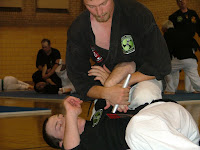 |
| Removing a knife using te-waza |
You are relaxing in your seat at 32,000 feet while flying across the country. You just started drinking coffee when the person in the seat in front of you jumps up and threatens another passenger. The airline attendants cower. You are the closest person but you can’t remember what to do. What do you do? Do you hide? Do you hope someone else jumps in? What do you do when the conflict expands? If only you had paid attention to that martial artist who demonstrated how to use hands, fingers, belts, pens, car keys to restrain an airline passenger in close quarters. What was that about the belt? How was that choke applied? Now you remember, you take off your belt, quickly throw the hot coffee in his face and then quickly restrain the passenger with that belt - just one of many techniques taught in the traditional martial arts of hojojutsu and kusari -fundo.
In karate, we have a profound understanding of our training known as Kara te or empty hand. 'Empty' used in this sense is related to a Buddhist term mushin that implies nothingness or emptiness. It simply indicates that to use martial arts effectively, one must be able to react to any circumstance without thinking - even at 32,000 feet. Thinking just clouds the mind.
How does one do this? Simply by training nearly every day for the rest of your life – sounds a little extreme! Not really, many people go to a gym 3 or 4 times a week or run a few days a week: think of karate as your weekly physical fitness training to burn calories with the added benefit of learning how to defend yourself! Getting muscle bound doesn't help much when a skinny guy kicks sand in your face on the beach.
How does one do this? Simply by training nearly every day for the rest of your life – sounds a little extreme! Not really, many people go to a gym 3 or 4 times a week or run a few days a week: think of karate as your weekly physical fitness training to burn calories with the added benefit of learning how to defend yourself! Getting muscle bound doesn't help much when a skinny guy kicks sand in your face on the beach.
 |
| Wrist restraint. applied to Shihan-Dai Kyle Gewecke. |
I remember when I was in high school – a friend snuck up behind me and lightly struck me in the face from behind – not hard, but enough that it got my attention. Without thinking, I automatically struck this person with a back elbow strike to the head – a knockout! How embarrassing, but my friend learned about mushin first hand. Not long after, I found myself once again in the vice principal’s office trying to explain to him about mushin. He was not a Buddhist or martial artist and had no idea of what I was talking about - and this was back in 1966 when few people had any concept of martial arts in the US. I was put on probation for striking another student. All this poor guy did was walk by me between classes and quickly raised his hand to brush his hair - my mushin mind apparently interpreted this movement as an act of aggression and I promptly hit him with a back fist. This was all in high school and I was started to develop a reputation - at least with Dr. Blackhurst, our vise principal.
When I was attacked on the UNM campus in Albuquerque some years later while in graduate school, my non-thinking brain (mushin) came to my rescue sending one of the two assailants to the hospital.
When I was attacked on the UNM campus in Albuquerque some years later while in graduate school, my non-thinking brain (mushin) came to my rescue sending one of the two assailants to the hospital.
You may be thinking – if only I would have continued to train in martial arts – I could deal with this kind of attack on the plane. Caught you! Quit thinking!
If you were properly trained in traditional martial arts, you would have been prepared. You could have choked the person, one quick punch to his throat, nose, or liver would have ended the confrontation, a kick to the knee, or if you had your cell-phone, you could have struck the side of his neck, groin, upper lip. Or if he came at you with a knife or sharpened pen, you could use your belt, the demo belt from the airline attendant, your magazine or even your book. But only if you had taken that class in traditional karate or the clinic in airline traveler self-defense.
 |
| Using a kuboton (stick, pencil, keychain, pen or Duck Commander duck call) to restrain an assailant. |
At the Hombu, in Arizona, members constantly train in self-defense, karate, jujutsu, weapons and much more. Airline attendants should all train in martial arts. And if we taught our children martial arts, there would be fewer problems worldwide, because traditional martial arts, unlike most sport martial arts or MMA, require the students to learn discipline and respect of the traditional Okinawan karate way.
 |
Lenny Martin sensei, applies thumb throw to Kyle Gewecke,Shihan-Dai
at University of Wyoming jujutsu clinic taught by Soke Hausel.
|


No comments:
Post a Comment